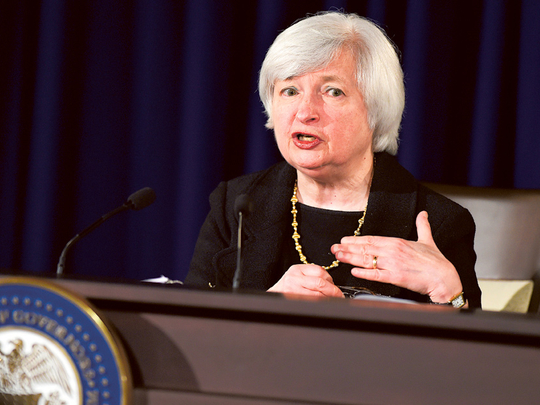
San Francisco, New York: Federal Reserve Chair Janet Yellen persuaded two hawkish colleagues to join her pledge on Wednesday to keep interest rates low for a long while, winning them over by sounding an optimistic tone on the US job market and inflation.
Charles Plosser and Richard Fisher, chiefs of the regional Philadelphia and Dallas Fed banks, respectively, had dissented at the US central bank’s last meeting in September and had argued for ditching a promise not to raise rates for a “considerable time” after ending a bond-buying stimulus programme.
But on Wednesday the pair joined most others on the Fed’s policy-setting committee, giving Yellen a strong 9-1 backing for a statement that applauded gradual improvements in the labour market and that dismissed recent inflation weakness as being due to temporary energy price drops.
‘Hawkish’ policymakers tend to be most focused on the threat of inflation, advocating higher rates, whereas ‘dovish’ ones are moved more by the threat of high unemployment, and often push for easier monetary policy.
Plosser and Fisher are bound by Fed rules that prohibit them from explaining their votes until Friday at the earliest, but analysts said it was clear the confidence the Fed expressed in the domestic economy made them happy.
‘More sensitive to labour market’
“The hawks were a bit more sensitive to the labour market and the fact that you’ve seen a change in the way the labour market is characterised; she won over the hawks with that, I think,” said Thomas Costerg, New York-based economist at Standard Chartered Bank.
The Fed, which previously had said job market slack was “significant,” dropped that adjective on Wednesday and said underutilisation of labour market resources was “gradually diminishing”. Costerg said the change “probably got the hawks back on board.”
Investors also took the Fed’s statement as hawkish, with futures traders now pricing in a 54 per cent chance of a September 2015 rate hike. Before the meeting, traders had seen October 2015 as the first likely timing for a rate increase.
A market sell-off this month, set off in part by weak economic data out of Europe and China, depressed readings of inflation expectations and left some investors anticipating the Fed would acknowledge those risks.
The absence of any discussion of recent market turmoil in the statement may have helped convince Fisher, typically sceptical of attempts to adjust Fed action to soothe markets, to get behind the Fed’s decision, said Gary Pzegeo, who helps manage $25.6 billion (Dh94 billion) at Atlantic Trust Private Wealth Management in Boston.
Pzegeo said comments since the Fed’s last meeting from Yellen and Fed Vice-Chair Stanley Fischer that downplayed the firmness of the “considerable time” promise, while playing up the importance of data in shaping interest-rate decisions, may also have been pivotal in assuaging the hawks’ concerns.
“We won’t know for certain until one of them opens their mouth... or when the minutes [of the meeting] are released” three weeks from now, he said.
In the end only one Fed official, the dovish Minneapolis Fed President Narayana Kocherlakota, dissented, citing lower inflation expectations.
“We think the shift to a hawkish overall Fed has commenced, and the pure hawks are appeased and winning and the pure doves losing,” said Brean Capital’s Peter Tchir.












